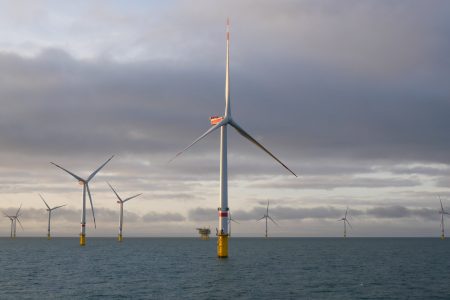
Renewables developer Luxcara sealed a contract on Tuesday (2 July), which will see 16 Chinese wind turbines installed in Germany for the first time, adding fuel to EU industry fears of being overtaken by competition from abroad.
Wind turbines installed in the European Union have historically been made in Europe and unlike other clean-tech sectors, the EU is home to global players like Vestas and Siemens, which have traditionally supplied the bloc.
But Chinese companies—who are said to produce considerably cheaper turbines—have been making inroads over the past years. Multiple large EU countries, including France, are home to wind turbines made in China today, but Germany, Europe’s largest wind market, has so far eluded Chinese producers.
But on 2 July, Luxcara, a German renewables developer based in Hamburg, announced it had struck a deal – known as a “preferred supplier arrangement” – with Chinese powerhouse Mingyang for 16 offshore wind turbines to be built in the North Sea by 2028.
“By deciding for [sic] the world’s most powerful offshore wind turbine, we will be able to expedite Germany’s energy transition while fostering much-needed competition in the industry,” said Holger Matthiesen, who manages the Waterkant project that won a bid to build turbines last year.
The large turbines, with a rotor diameter of 260 metres and a capacity of 18.5 MW each, will be installed near North Sea island Borkum by 2028.
Luxcara’s announcement comes three months after lawmakers approved into EU law the Net-Zero Industrial Act, which aims to defend the EU’s share in key clean-tech industries like wind and solar, came into force.
“With this project, China gets access to critical infrastructure in Germany,” said a spokesperson of WindEurope, the industry’s lobby group in Brussels, adding that the “European supply chain would have been ready to deliver the wind turbines for this project.”
One of the instruments most anticipated by the European wind industry will be cybersecurity criteria – opening a door to barring Chinese turbines from the EU on national security grounds, similar to the treatment of telecoms giant Huawei, should EU countries want it.
Luxcara says it did its due diligence, and the project was “aligned with the EU taxonomy and cyber security supported by independent experts from international advisors DNV and KPMG.”
To add, “management, operation and control of the Waterkant wind farm will remain entirely in the hands of an independent German company,” explains Matthiesen.
Some parts will be produced in Europe, Luxcara added.
“Germany and the European Union must consider whether they see wind energy as a strategic sector before it is too late,” the WindEurope spokesperson said.
Some political backing comes from the Greens.
“We must not allow major industrial projects to be used to feed Chinese competition instead of building up Europe’s own industry,” said Michael Bloss, a green EU lawmaker from Germany.
“Such an economic policy is naive because China is currently preparing the de-industrialisation of Europe,” he told Euractiv.
The EU’s wind industry has repeatedly sought to rally EU countries behind its cause, which ultimately saw 26 energy ministers sign a supportive ‘EU Wind Charter’ in late 2023.
Then, they endorsed a commitment to “actively monitoring and, if justified, consider measures to address possible unfair trade practices in the international market for wind-related products.”
[Edited by Donagh Cagney/Alice Taylor]
Take the Survey at https://survey.energynewsbeat.com/






